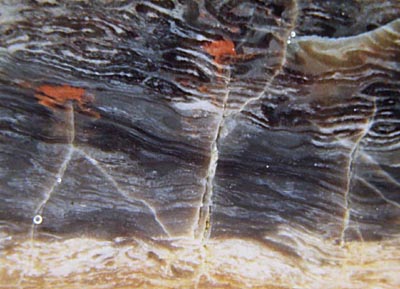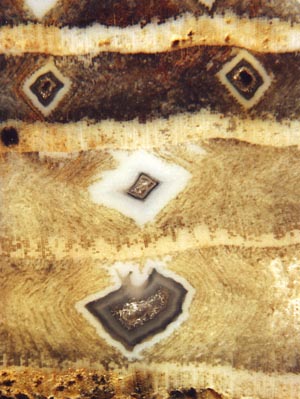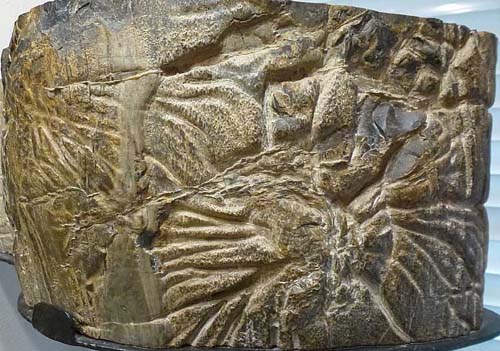Cracks
 Crack initiation and propagation is a highly complex and interesting
phenomenon. Part of it will be considered in more detail later.
Meanwhile a few facts about cracks are stated here, including more or
less trivial ones.
Crack initiation and propagation is a highly complex and interesting
phenomenon. Part of it will be considered in more detail later.
Meanwhile a few facts about cracks are stated here, including more or
less trivial ones.
Fig.1: Silicified peat consisting of squeezed Psaronius with
narrow
cracks apparently defying any reasonable explanation.
Fig.2: Fossil wood with
wide tunnel-like cracks whose formation can be
essentially understood as brought about by some
combination of shrinkage, mechanical anisotropy, silica deposition, and
deformation under
vertical compression. (See Funny
Faces.)
 Cracks
may appear if the
tensile stress exceeds the mechanical strength of a material. (Some
materials do not fail by fracture but by flow.)
Cracks
may appear if the
tensile stress exceeds the mechanical strength of a material. (Some
materials do not fail by fracture but by flow.)
Stress
may be transient as in impact or permanent as under applied load.
Shrinkage gives rise to tensile stress if
restricted by constraints.
The question whether stress is the cause of
strain or vice versa is meaningless.
In case of variable strength, the
crack chooses an easy path.
Although most of the cracks seen on cut chert faces will probably
never be really understood, trying to draw information from cracks may
be worth the effort.
The decay-resistant cuticles on the surface of land plants
make discontinuities in the chert which are faces of low strength,
which means easy crack paths.
Therefore, the crack running along the spherical surface of Pachytheca
indicates that this "enigmatic organism" was covered by a cuticle and
thus adapted to sub-aerial conditions.
Most
of the cracks seen in cherts had been healed soon after their formation
by deposition of silica in the gap, possibly from the same source which
provided silica for chert formation. Cracks
which did not
heal may have led to the disintegration of the chert layer into
rectangular or polygonal fragments found now among the gravel of
ancient and recent streams.
Narrow cracks with hardly visible gap had formed most
probably in hard and brittle material. Very wide shrinkage
cracks as
they are occasionally seen in petrified peat
and petrified wood
must have formed in an early stage of silicification when the silica
gel was still so weak that it did not preclude further shrinkage but
was able
to keep the fragments suspended in their original position.
There
are cases where cracks can help to reconstruct the sequence of events
which led to the final aspect of the sample. A wide crack through a
white spot
in petrified wood proves that the spot had formed at an early stage
when all was still
soft, contrary to another hypothesis.
Cracks which are narrow in the depth but
widen into a V-shape
on the surface as in the image on the right are secondary formations
resulting from spalling fracture due to repeated impact of pebbles and
boulders on the edges. They have been mistaken for damage by insects.
Cracks due to interface debonding can bring forth unexpected
shapes.
The danger of misinterpretation
of cracks as cell walls
of fossil plants is there, especially with fossil polygonal
crack patterns.
Crazy cracks which seem to defy any explanation are seen here : Fossil Wood News 39.
H.-J.
Weiss
2012
updated
2014, 2021

 Cracks
may appear if the
tensile stress exceeds the mechanical strength of a material. (Some
materials do not fail by fracture but by flow.)
Cracks
may appear if the
tensile stress exceeds the mechanical strength of a material. (Some
materials do not fail by fracture but by flow.) 